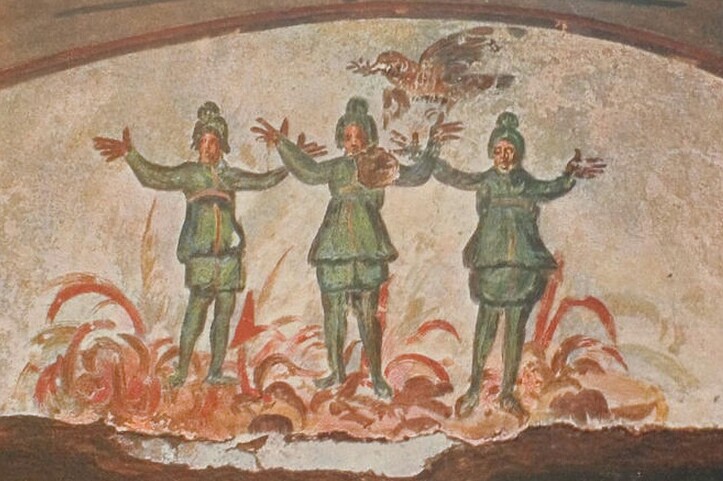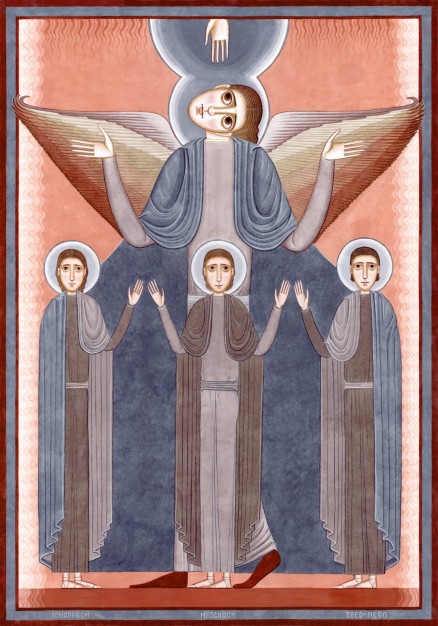And Why Put It In a Baptistry?
Old Testament Appearances of the Son of God. Redemption Through Water and the Spirit in the Book of Daniel
Have a look at this ancient wall painting of Daniel and his companions in the fiery furnace. It is from the Roman catacombs and is one of the images that is included in the Catechism of the Catholic Church below.
Scripture tells us of the fate of Daniel’s three friends (Daniel 3: 49, Knox translation). It says that an ‘angel of the Lord had gone down into the furnace with Azarias and his companions and drove the flames away from it, making a wind blow in the heart of the furnace, like the wind that brings the dew. So that these three were untouched, and the fire brought them no discomfort. Whereupon all of them, as with one mouth, began to give praise and glory and blessing to God, there in the furnace.’ Afterwards, the king who had thrown the youths into the fire, Nebuchnudnezah said he saw four figures, and the fourth was ‘as it had been a son of God’ (v92).

We recently discussed this passage in scripture class by Fr Sebastian Carnazzo, the Psalms and Canticles of the Divine Office in Words, Images and Prayer, an elective in Pontifex University’s Master’s in Sacred Arts program. We were discussing it because the song that the three subsequently sang is known as the Canticle of Daniel and is sung on Feast days at Lauds.
The reference to the wind and the dew in the scriptural account has been connected to the Creation story in which the Spirit of God was over the water, and then to the baptism of Christ in which the Holy Spirit comes down and the sacrament of baptism is initiated. Baptism is, through water, the dying of the old self spiritually so that we can be resurrected spiritually in Confirmation or Chrismation by the action of the Holy Spirit.
There is a similar connection to the passages describing the crossing of the Red Sea and the crossing of the Jordan by Joshua, in which the water and wind are connected. Wind is the action of the Spirit, as is fire (as at Pentecost which the Church Fathers also connected to the burning bush).
These common themes are the reason why traditionally in baptistries we would see portrayals of all these scenes, as described here.
So who is the fourth figure?
He can be represented simply as ‘an angel of the Lord’, as in this contemporary icon by Nicola Saric:

Some Church Fathers identified the figure as a pre-incarnational appearance of Christ, as in the tale of the three figures in the Hospitality of Abraham in Genesis, and the voice in the Burning Bush speaking to Moses. So in this icon, this is made explicit by the artist. The ‘IC XC’ and the cross in the icon tell us that this is Christ.

The painting in the catacomb we referred to initially seems not to show either of these. Rather, he appears not to be showing the fourth figure at all, but is giving us, perhaps, the personification of a fifth person, the Spirit as a bird, a dove perhaps, so connecting this scene of an Old Testament redemption to the Baptism of Christ which opens the way to our redeption.

This New Testament resurrection in the spirit is available to all men through the Church, right now in this life, and is every bit as miraculous and wonderful as the saving of the three youths. We are partaking of the divine nature and the living out of the sacramental life of the Church which opens the way to a life of the greatest joy, if only we could believe it.
Regardless of the precise aspect of the theology that each artist has decided to portray, the full story that they reveal really should give us cause to praise God daily, just as the youths did, and sing their canticle in the Liturgy of the Hours!
